Feeling a Hot Flash? How Yoga for Menopause Might Help Your Symptoms

When Alison, 48, began experiencing intense hot flashes, they often arrived at night and interrupted her sleep. But on the whole, her perimenopausal symptoms were more annoying than unbearable. Then her menstrual cycle spun out of control. “Suddenly, my menstrual flow was really heavy and lasted twice as long as before,” says Alison, who lives in Chicago and requested that her last name not be used. “My periods went on forever.” Her gynecologist suggested that Alison try hormone replacement therapy (HRT), prescription drugs used to control menopausal symptoms. “She told me not to rule it out if my symptoms were really bad, but my feeling was that I’d rather try to just get through them,” Alison says.
She had good reason for wanting to avoid HRT. The treatment regimen, which artificially elevates a woman’s estrogen and progesterone levels, has come under intense scrutiny in recent years. Major studies have linked it to an increased risk of breast cancer, heart disease, strokes, and other life-threatening conditions.
Soon after Alison’s menstrual cycles became so irregular, she went to class at Yoga Circle, her regular studio, and learned an Iyengar asana sequence designed to help women cope with the physical discomforts related to their cycles. Many of the poses were restorative; they included Supta Virasana (Reclining Hero Pose), Supta Baddha Konasana (Reclining Bound Angle Pose), and Janu Sirsasana (Head-of-the-Knee Pose) with the head supported. When Alison’s next menstrual period began, she practiced the sequence every day and noticed that her flow returned to normal. Encouraged by the results, she began to think that she could control her symptoms without HRT. Maybe, she thought, yoga could provide the relief she was looking for. And her intuition proved correct. Many women have found that yoga can ameliorate the undesirable side effects of menopause.
See also Yoga for Menopause: Alleviate Symptoms with Yoga
Yoga for Hormonal Imbalances
Though menopause itself is simply the moment that menstruation stops, the transition generally takes several years. This phase is called perimenopause and typically occurs in women between the ages of 45 and 55. During perimenopause, fluctuating estrogen and progesterone levels can trigger a myriad of uncomfortable symptoms. Among the most common are hot flashes, anxiety and irritability, insomnia, fatigue, depression and mood swings, memory lapses, and an erratic menstrual cycle.
Few women experience all of these, but an estimated 55 to 65 percent of them do experience some mild menopause-related problems, says Rowan Chlebowski, MD, of the Harbor UCLA Research and Education Institute in Torrance, California. About 25 percent report almost no disruption to their daily lives, while approximately 10 to 20 percent suffer severe and often debilitating symptoms.
Hormonal fluctuations generally accompany women’s passages into each new biological stage of life; with them often come various discomforts, such as acne and mood swings at puberty, morning sickness during pregnancy, and postpartum depression. “Menopause is no exception,” says Nancy Lonsdorf, MD, author of A Woman’s Best Medicine for Menopause.
Before the onset of perimenopause, a woman’s menstrual cycle is set in motion each month by the hypothalamus, a small structure at the base of the brain that regulates many bodily functions, including appetite and temperature. The hypothalamus signals the pituitary gland to produce important hormones for reproduction, and those hormones in turn stimulate production of estrogen and progesterone in the ovaries. During perimenopause, the ovaries and pituitary gland engage in a kind of tug-of-war. The ovaries decrease hormone production, while the pituitary gland, sensing low hormone levels, continues to spur on the ovaries. This frenetic struggle causes erratic hormonal fluctuations—too much estrogen, which revs the body’s motors, followed by spikes of progesterone, which slows the body.
See also The Best Pose and Acupressure Point to Reduce Bloating
“Hormones are very powerful; they affect just about every tissue of the body,” Lonsdorf says. “So it’s no wonder that various conditions can arise as the body tries to adjust to these hormonal shifts. For instance, when the brain is affected by erratic hormone patterns, sleep, mood, and memory may all be influenced, and when the uterus is stimulated by sporadic hormone patterns, irregular bleeding occurs, and so on.”
Typically, a woman experiences the first signs of this hormonal fluctuation about six years before her menstrual periods end. These symptoms generally continue until a year or more after her last period, when the hormone levels gradually stabilize. After menopause, the ovaries produce less of the female hormones. However, the body still needs some estrogen to keep the bones healthy and to prevent conditions like vaginal dryness. The adrenal glands, which are located above the kidneys, play an important role in this by secreting low levels of male hormones that are converted by fat cells into estrogen. Still, the body must adjust to a new, much lower hormone level.
These natural physiological changes and the havoc they can wreak for many women prompted researchers in the late 1960s to seek a solution for common menopausal symptoms. The treatment they ultimately proposed was HRT. Their reasoning was that problems stemming from declining estrogen levels could simply be eliminated if the missing hormones were replaced. Scientists believed that maintaining hormone levels similar to what the body was used to would provide relief.
HRT was a simple solution for managing menopausal symptoms. But since several major studies have shown that HRT exposes women to serious health risks, many women have begun seeking more natural solutions. Those who have turned to yoga for relief have found that while asana may not directly influence estrogen production, specific postures can help control unpleasant symptoms. Restorative postures in particular can relax the nervous system and may improve the functioning of the endocrine system (especially the hypothalamus, the pituitary gland, the thyroid, and the parathyroid gland), which helps the body adapt to hormonal fluctuations.
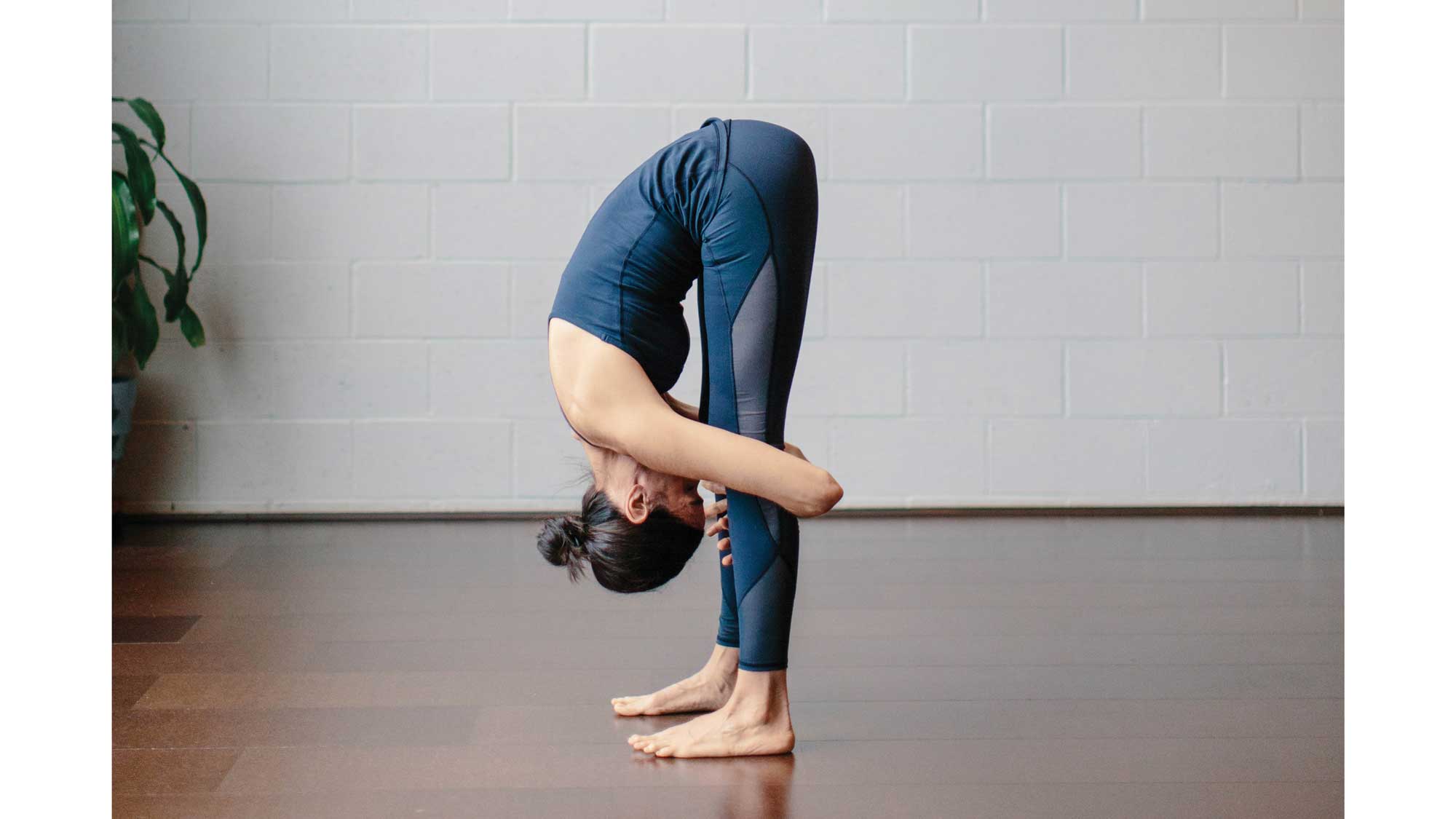
Alleviating the Symptoms of Menopause
Yoga instructor Patricia Walden, 57, knows firsthand how yoga can help temper menopausal complaints. Like many other women’s symptoms, hers arrived like rain: first a sprinkle, then a full-fledged storm. Hot flashes came first, and then—for the next year—she suffered through constant fatigue and insomnia. She often awoke in the night and stayed awake for up to three hours.
On the days when Walden had intense symptoms, she found she needed to modify her yoga routine. She was accustomed to a vigorous daily practice but discovered that unsupported inversions, strenuous poses, and backbends sometimes made her symptoms worse. When that happened, she turned to supported and restorative poses to calm her nerves. She still did inversions, but instead of an unsupported Sirsasana (Headstand), which sometimes brought on more hot flashes, she would do Setu Bandha Sarvangasana (Bridge Pose) using bolsters or Salamba Sarvangasana (Supported Shoulderstand) with a chair. With these modifications, Walden was able to reap the benefits of inversions—relief from anxiety and irritability—without challenging or heating her body.
As Walden’s symptoms diminished, her conviction that yoga could be a potent tool for easing the suffering that accompanies hormonal shifts deepened. She began to connect with other women who were experiencing similar difficulties and has since created specific yoga sequences for women with menopausal symptoms. “I was interested in women’s issues before,” says Walden, co-author with Linda Sparrowe of The Woman’s Book of Yoga and Health: A Lifelong Guide to Wellness. “But after having gone through menopause myself, I am much more sensitive to it.”f
See also Yoga for Women’s Health: The Best Type of Practice for Each Phase of Your Menstrual Cycle
A regular yoga practice can make a world of difference in a woman’s experience of menopause. And a solid practice before this phase can ease the transition, says Suza Francina, author of Yoga and the Wisdom of Menopause. “If you practice yoga before menopause, then all the poses that are especially useful for coping with uncomfortable symptoms are already familiar, and you can reach for them like an old friend,” she says. “If you are familiar with restorative poses, then you have the best menopause medicine at your disposal.”
Yoga Poses for Every Menopause Symptom
Here are descriptions of the most common symptoms and specific recommendations for taming them.
Yoga for Hot Flashes
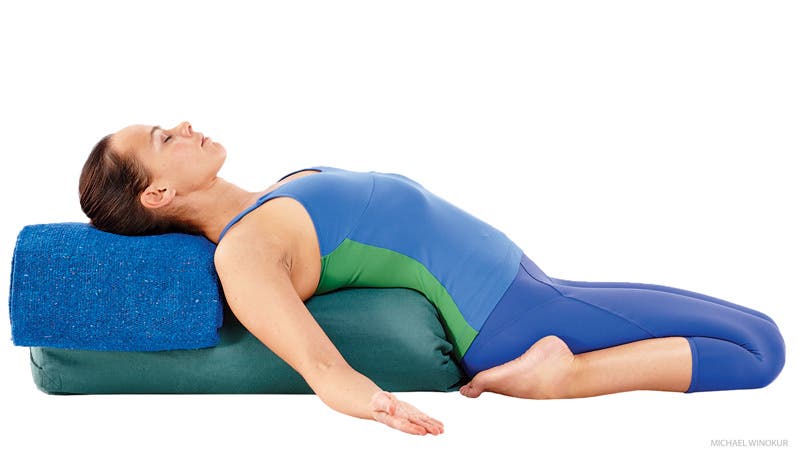
One of the most common (and mysterious) symptoms, hot flashes are experienced by nearly 80 percent of all women during perimenopause. Characterized by a rise in core body temperature coupled with a rapid pulse rate, these “power surges” produce a blushing that begins in the face and spreads down the neck and arms. Hot flashes can disappear as quickly as they appear, often leaving a woman feeling chilly and clammy as her body tries to correct the temperature fluctuation.
No one really knows what causes hot flashes, although theories abound. Some say the hypothalamus plays an important role; another possibility is that the hormonal fluctuations in the body irritate the blood vessels and nerve endings, causing the vessels to overdilate and producing a hot, flushed feeling. Most researchers (as well as many menopausal women) agree that stress, fatigue, and intense periods of activity tend to intensify these episodes.
Walden suggests incorporating more cooling and restorative poses. Any gripping or tension in the body can make hot flashes worse, so using props such as bolsters, blankets, and blocks to help support the whole body is a good idea. Placing the head on a bolster or chair during forward bends, for example, helps calm the brain and relax the nerves. Supported reclining poses can also help promote complete relaxation. Reclining Bound Angle Pose and Reclining Hero Pose, for instance, allow the abdomen to soften and tightness in the chest and belly to release. Ardha Halasana (Half Plow Pose) with the legs resting on a chair calms jittery nerves.
See also Yoga for Menopause: Alleviate Symptoms with Yoga
Yoga for Memory
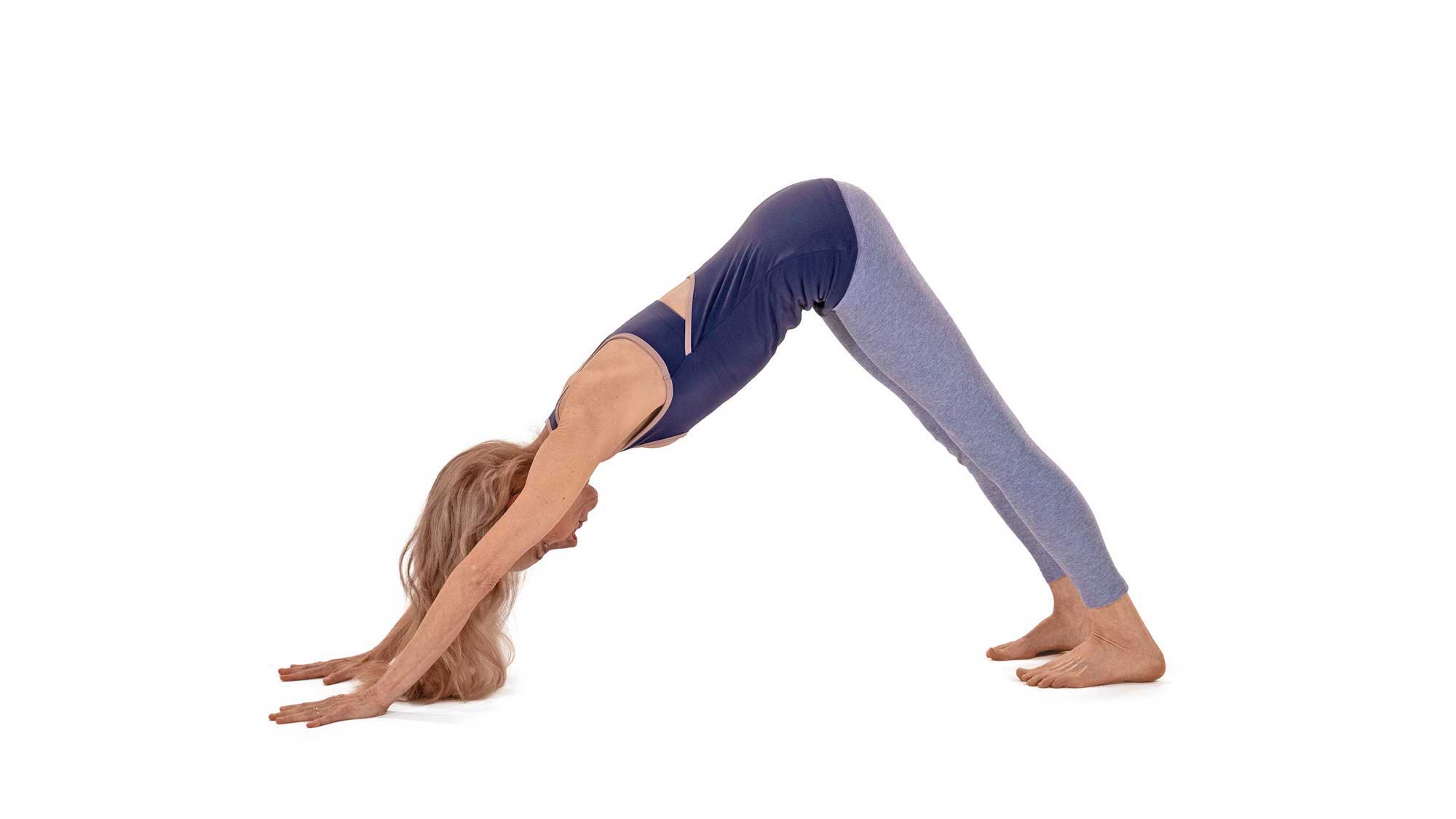
At times during menopause, some women suddenly lose their train of thought or nd themselves unable to organize their thoughts. This “fuzzy” thinking often happens at moments of great hormonal fluctuation. Girls going through puberty, pregnant women, and those who have just given birth often suer similar levels of fogginess. Many women nd that yoga helps clear the cobwebs, especially if their condition is exacerbated by lack of sleep or increased agitation. The same postures that counter depression, such as backbends, chest openers, and inversions, can help collect fragmented thoughts, says Walden.
In addition, Adho Mukha Svanasana (Downward-Facing Dog Pose) sends blood to the brain and encourages deep, focused breathing, which can improve mental alertness. And Savasana (Corpse Pose) soothes the nerves, calms the mind, and puts the body into a state of repose.
These asanas are just a sampling of the tools a woman can equip herself with as she journeys through menopause—and beyond. If you’ve never practiced before, yoga can be a tremendous aid when your body feels out of control. If your yoga has been a companion for years, you might nd that this is a good time to modify your practice to give your body what it needs. Yoga’s rewards, after all, are life long. As Alison puts it, “I have received so many incredible benets from yoga, especially during this period in my life. It has physically improved my body and mentally helped me with the ups and downs.”
See also Yoga for Women’s Health: The Best Pose & Acupressure Point to Reduce Irritability During Your Period
Yoga for Fatigue
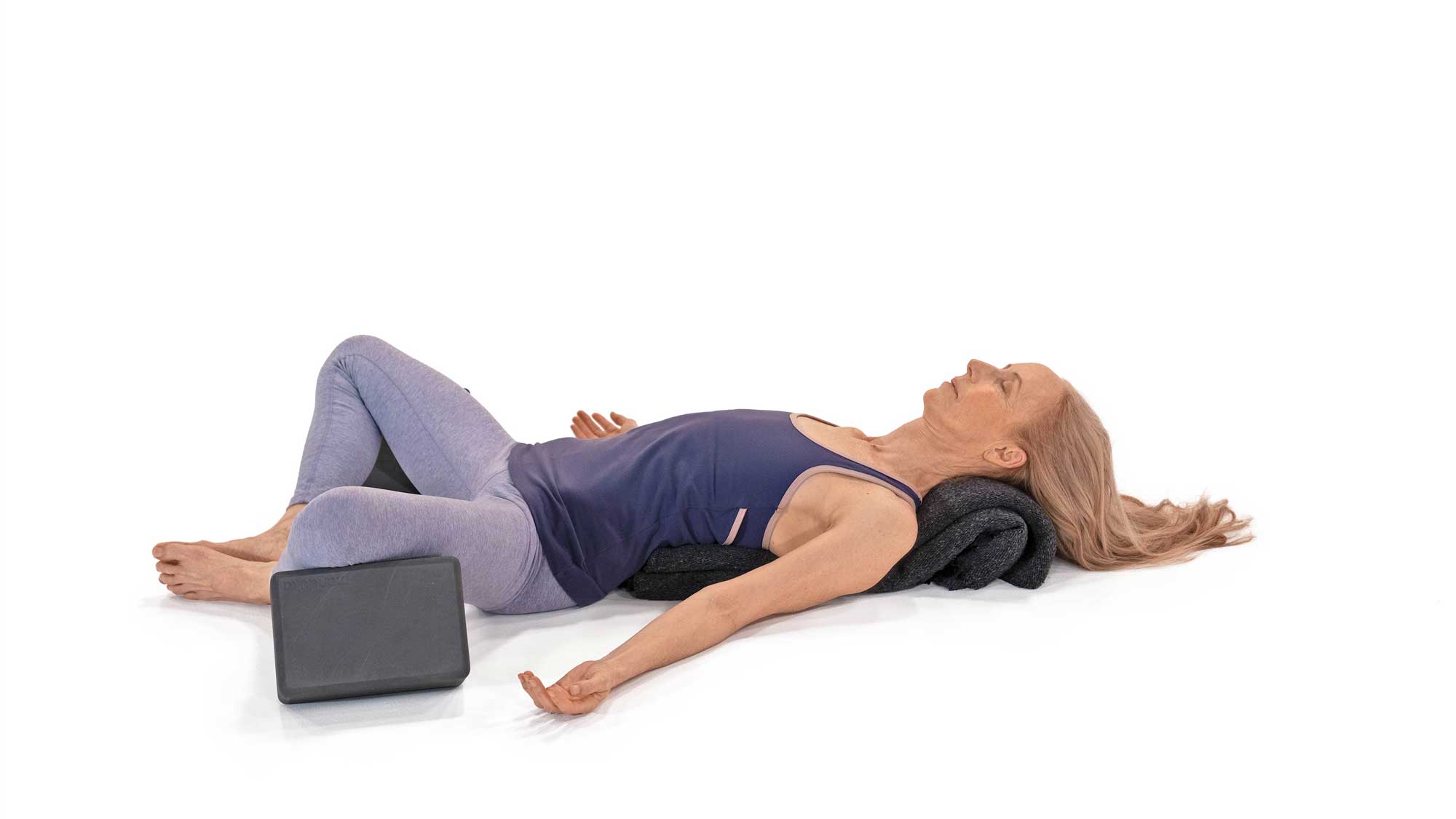
Of all the symptoms women complain about during perimenopause, fatigue is second only to hot flashes. Plunging progesterone could be the culprit, especially if the fatigue is coupled with depression and lethargy; if a woman feels inexplicably weary for days or weeks on end, depleted adrenal glands could be part of the problem.
Either way, Walden suggests gentle supported backbends because they encourage the chest and the heart to open and often bring renewed energy, determination, and joy. One of her favorites for this is Supta Baddha Konasana. A deeply restorative posture, it can instill feelings of safety and nourishment. It also opens the chest, improves respiration and circulation, and helps lift the spirits while completely supporting the body.
See also Is It Adrenal Fatigue? What You Need to Know if You Feel Tired All the Time
Yoga for Anxiety, Irritability, and Insomnia

During perimenopause, estrogen spikes (or progesterone plummets), causing anxiety, nervousness, and irritability. Adrenal glands that are exhausted and overtaxed can also produce bouts of anxiety and intense irritability. (Many alternative healers believe that the adrenals can wear themselves out by constantly responding to stress, a poor diet, and lack of sleep.)
When a person is under stress, the sympathetic nervous system responds by accelerating the heart rate, slowing down the muscles of the digestive tract, and increasing blood circulation to the brain to fight the stressor.
Once the stress dissipates, the parasympathetic nervous system responds by doing just the opposite–slowing the heart rate back to normal, stimulating the smooth muscles of the digestive tract, and bringing the body’s systems back into balance.
When the body is under continual stress, the sympathetic nervous system and the adrenals—which manufacture stress-fighting hormones along with the male hormones that get converted into estrogen—can get stuck in overdrive.
Walden says forward bends, such as Uttanasana (Standing Forward Bend) and Prasarita Padottanasana (Wide-Legged Standing Forward Bend)—in both cases with the head resting on a bolster or blankets—can help reduce irritability and mental tension, because bending forward and shutting out external distractions and stimuli can soothe the mind and reduce the effects of stress. The nervous system then receives the signal that all is well, and the adrenals and sympathetic nervous system stop working so hard.
If insomnia is a problem, inversions can sometimes help, because they ground the body’s energy and burn off excess anxiety. When followed by restorative postures, they encourage a deep state of rest.
See also YJ Tried It: 30 Days of Guided Sleep Meditation
Yoga for Depression and Mood Swings
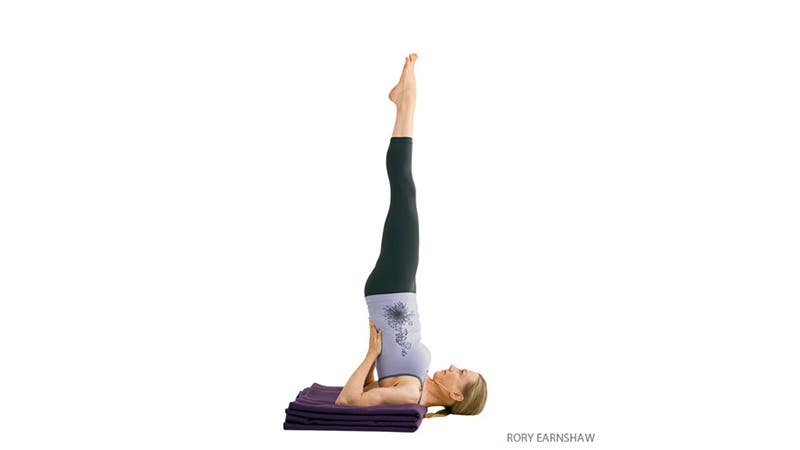
Menopause signals the end of the childbearing years; for many women, it is a time to mourn the end of their youth. Long periods of fatigue, coupled with a melancholy attitude or a sense that the life they once knew is now over, can trigger bouts of depression. Too much progesterone (or a drastic drop in estrogen) can also contribute to everything from a bad case of the blues to severe clinical depression.
But yoga practitioners have long known that everything you do with your body can affect your thoughts and attitude. Sometimes something as subtle as a shift in posture can lighten a dark mood. If a woman stands tall with dignity—opening and broadening her chest—and walks with confidence, she announces to the world (and, most important, to herself) that she is grounded, happy, and in tune with her surroundings.
Walden has found that specific poses create a mental state that positively affects the mind. “Backbends, especially if supported, allow a sense of lightness into the body,” she says. “They stimulate the adrenals and massage them into action. Also, the heart and lungs open and take in more oxygen.” Chest-expanding poses energize the body by improving respiration and circulation, and thus counter feelings of depression. And many yogis have discovered that inversions, such as Shoulderstand, can help improve a depressed mood. “By turning everything upside down, inversions influence your emotional being in a positive way,” Walden says.
See also The Happiness-Boosting Pose You Need in Your Practice
About the Author
Trisha Gura is a freelance science writer and yoga student in Boston. Find her trishagura.com.